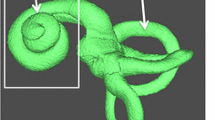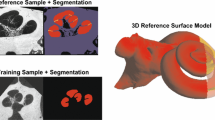Abstract
Purpose
Cochlear implantation is a safe and effective surgical procedure to restore hearing in deaf patients. However, the level of restoration achieved may vary due to differences in anatomy, implant type and surgical access. In order to reduce the variability of the surgical outcomes, we previously proposed the use of a high-resolution model built from \(\mu \hbox {CT}\) images and then adapted to patient-specific clinical CT scans. As the accuracy of the model is dependent on the precision of the original segmentation, it is extremely important to have accurate \(\mu \hbox {CT}\) segmentation algorithms.
Methods
We propose a new framework for cochlea segmentation in ex vivo \(\mu \hbox {CT}\) images using random walks where a distance-based shape prior is combined with a region term estimated by a Gaussian mixture model. The prior is also weighted by a confidence map to adjust its influence according to the strength of the image contour. Random walks is performed iteratively, and the prior mask is aligned in every iteration.
Results
We tested the proposed approach in ten \(\mu \hbox {CT}\) data sets and compared it with other random walks-based segmentation techniques such as guided random walks (Eslami et al. in Med Image Anal 17(2):236–253, 2013) and constrained random walks (Li et al. in Advances in image and video technology. Springer, Berlin, pp 215–226, 2012). Our approach demonstrated higher accuracy results due to the probability density model constituted by the region term and shape prior information weighed by a confidence map.
Conclusion
The weighted combination of the distance-based shape prior with a region term into random walks provides accurate segmentations of the cochlea. The experiments suggest that the proposed approach is robust for cochlea segmentation.










Similar content being viewed by others
Notes
The performance measures are defined as: \(\mathrm{Overlap}= \frac{\mathrm{TP}}{\mathrm{TP}\,+\,\mathrm{FN}\,+\,\mathrm{FP}}\), \(\mathrm{Sensitivity}= \frac{\mathrm{TP}}{\mathrm{TP}\,+\,\mathrm{FN}}\), \(\mathrm{Specificity}=\frac{\mathrm{TN}}{\mathrm{TN}\,+\,\mathrm{FP}}\) and \(\mathrm{Similarity}= \frac{2\mathrm{TP}}{2\mathrm{TP}\,+\,\mathrm{FN}+\mathrm{FP}}\) where TP and FP stand for true positive and false positive, respectively, and TN and FN stand for true negative and false negative, respectively.
References
Eslami A, Karamalis A, Katouzian A, Navab N (2013) Segmentation by retrieval with guided random walks: application to left ventricle segmentation in MRI. Med Image Anal 17(2):236–253
Li K-C, Su H-R, Lai S-H (2012) Pedestrian image segmentation via shape-prior constrained random walks. In: Ho Y-S (ed) Advances in image and video technology. Springer, Berlin, pp 215–226
Wilson BS, Dorman MF (2008) Cochlear implants: a remarkable past and a brilliant future. Hear Res 242(1):3–21
Boyd PJ (2011) Potential benefits from deeply inserted cochlear implant electrodes. Ear Hear 32(4):411–427
Ceresa M, Lopez NM, Velardo HD, Herrezuelo NC, Mistrik P, Kjer HM, Vera S, Paulsen RR, González Ballester MA (2014) Patient-specific simulation of implant placement and function for cochlear implantation surgery planning. In: Golland P, Hata N, Barillot C, Hornegger J, Howe R (eds) Medical image computing and computer-assisted intervention—MICCAI 2014. Springer, Berlin, pp 49–56
Ceresa M, Mangado N, Andrews RJ, González Ballester MA (2015) Computational models for predicting outcomes of neuroprosthesis implantation: the case of cochlear implants. Mol Neurobiol 52(2):934–941
Kjer HM, Fagertun J, Vera S, González Ballester MA, Paulsen RR (2014) Shape modelling of the inner ear from micro-ct data. In: Symposium on statistical shape models and applications (Shape 2014)
Kjer HM, Vera S, Fagertun J, Perez F, Herrero J, González Ballester MA, Paulsen RR (2015) Predicting detailed inner ear anatomy from pre-operational CT for cochlear implant surgery. Int J Comput Assist Radiol Surg 10(Suppl 1):S98–S99
Gerber N, Bell B, Gavaghan K, Weisstanner C, Caversaccio M, Weber S (2014) Surgical planning tool for robotically assisted hearing AID implantation. Int J Comput Assist Radiol Surg 9(1):11–20
Xianfen D, Siping C, Changhong L, Yuanmei W (2006) 3D semi-automatic segmentation of the cochlea and inner ear. In: 27th annual international conference of the engineering in medicine and biology society, 2005. IEEE-EMBS 2005. IEEE, pp 6285–6288
Reda FA, McRackan TR, Labadie RF, Dawant BM, Noble JH (2014) Automatic segmentation of intra-cochlear anatomy in post-implantation CT of unilateral cochlear implant recipients. Med Image Anal 18(3):605–615
Noble JH, Labadie RF, Majdani O, Dawant BM (2011) Automatic segmentation of intracochlear anatomy in conventional CT. IEEE Trans Biomed Eng 58(9):2625–2632
Noble JH, Gifford RH, Labadie RF, Dawant BM (2012) Statistical shape model segmentation and frequency mapping of cochlear implant stimulation targets in CT. In: Medical image computing and computer-assisted intervention—MICCAI 2012. Springer, pp 421–428
Poznyakovskiy AA, Zahnert T, Kalaidzidis Y, Lazurashvili N, Schmidt R, Hardtke H-J, Fischer B, Yarin YM (2011) A segmentation method to obtain a complete geometry model of the hearing organ. Hear Res 282(1):25–34
Braun K, Böhnke F, Stark T (2012) Three-dimensional representation of the human cochlea using micro-computed tomography data: presenting an anatomical model for further numerical calculations. Acta Otolaryngol 132(6):603–613
Grady L (2006) Random walks for image segmentation. IEEE Trans Pattern Anal Mach Intell 28(11):1768–1783
Boykov Y, Veksler O (2006) Graph cuts in vision and graphics: theories and applications. In: Paragios N, Chen Y, Faugeras O (eds) Handbook of mathematical models in computer vision. Springer, Berlin, pp 79–96
Boykov Y, Veksler O, Zabih R (2001) Fast approximate energy minimization via graph cuts. IEEE Trans Pattern Anal Mach Intell 23(11):1222–1239
Baudin P-Y, Azzabou N, Carlier PG, Paragios N (2012) Prior knowledge, random walks and human skeletal muscle segmentation. In: Medical image computing and computer-assisted intervention—MICCAI 2012. Springer, pp 569–576
Li A, Li C, Wang X, Eberl S, Feng DD, Fulham M (2013) Automated segmentation of prostate MR images using prior knowledge enhanced random walker. In: 2013 international conference on digital image computing: techniques and applications (DICTA). IEEE, pp 1–7
Baudin P-Y, Azzabou N, Carlier PG, Paragios N (2012) Manifold-enhanced segmentation through random walks on linear subspace priors. In: Proceedings of the British machine vision conference
Baudin P-Y (2013) De la segmentation au moyen de graphes d’images de muscles striés squelettiques acquises par RMN. PhD thesis, Ecole Centrale Paris
Lee Y-T, Su T-F, Su H-R, Lai S-H, Lee T-C, Shih M-Y (2013) Human segmentation from video by combining random walks with human shape prior adaption. In: Signal and information processing association annual summit and conference (APSIPA), 2013 Asia-Pacific. IEEE, pp 1–4
Papoutsakis KE, Argyros AA (2010) Object tracking and segmentation in a closed loop. In: Bebies G, Boyle R, Parvin B, Koracin D, Chung R, Hammoud R, Hussain M, Kar-Han T, Crawfis R, Thalmann D, Kao D, Avila L (eds) Advances in visual computing. Springer, Berlin, pp 405–416
Grady L (2005) Multilabel random walker image segmentation using prior models. In: IEEE computer society conference on computer vision and pattern recognition, 2005. CVPR 2005, vol 1. IEEE, pp 763–770
Nakagomi K, Shimizu A, Kobatake H, Yakami M, Fujimoto K, Togashi K (2013) Multi-shape graph cuts with neighbor prior constraints and its application to lung segmentation from a chest CT volume. Med Image Anal 17(1):62–77
Kohli P, Rihan J, Bray M, Torr PHS (2008) Simultaneous segmentation and pose estimation of humans using dynamic graph cuts. Int J Comput Vis 79(3):285–298
Chen X, Udupa JK, Bagci U, Zhuge Y, Yao J (2012) Medical image segmentation by combining graph cuts and oriented active appearance models. IEEE Trans Image Process 21(4):2035–2046
Ruiz Pujadas E, Reisert M (2014) Shape-based normalized cuts using spectral relaxation for biomedical segmentation. IEEE Trans Image Process 23(1):163–170
Ruiz E, Reisert M (2013) Image segmentation using normalized cuts with multiple priors. In: SPIE medical imaging. International society for optics and photonics, pp 866937–866937
Bishop CM (2006) Pattern recognition and machine learning, vol 1. Springer, New York
Klein S, Staring M, Murphy K, Viergever MA, Pluim JPW (2010) Elastix: a toolbox for intensity-based medical image registration. IEEE Trans Med Imaging 29(1):196–205
Klein S, Pluim JPW, Staring M, Viergever MA (2009) Adaptive stochastic gradient descent optimisation for image registration. Int J Comput Vis 81(3):227–239. doi:10.1007/s11263-008-0168-y
Segmentation Validation Engine (2008) http://sve.bmap.ucla.edu/instructions/metrics/dice/. Accessed 10 Nov 2014
Acknowledgments
The research leading to these results received funding from the European Union Seventh Frame Programme (FP7/2007-2013) under Grant agreement 304857.
Author information
Authors and Affiliations
Corresponding author
Ethics declarations
Conflict of interest
Esmeralda Ruiz Pujadas, Hans Martin Kjer, Gemma Piella, Mario Ceresa and Miguel Angel González declare that they have no conflict of interest.
Animal and human participants
All human and animal studies have been approved.
Informed consent
All patients/volunteers gave their informed consent.
Rights and permissions
About this article
Cite this article
Ruiz Pujadas, E., Kjer, H.M., Piella, G. et al. Random walks with shape prior for cochlea segmentation in ex vivo \(\mu \hbox {CT}\) . Int J CARS 11, 1647–1659 (2016). https://doi.org/10.1007/s11548-016-1365-8
Received:
Accepted:
Published:
Issue Date:
DOI: https://doi.org/10.1007/s11548-016-1365-8




